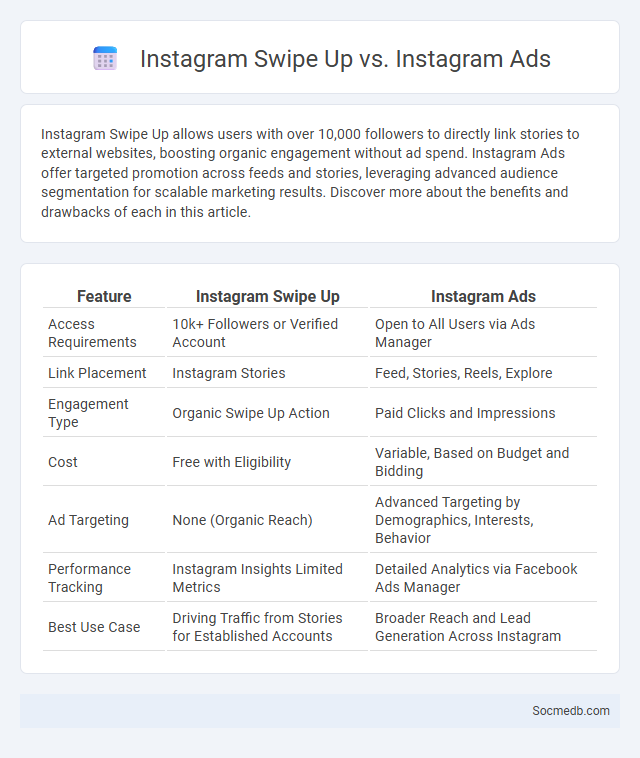
Photo illustration: Instagram Swipe Up vs Instagram Ads
Instagram Swipe Up allows users with over 10,000 followers to directly link stories to external websites, boosting organic engagement without ad spend. Instagram Ads offer targeted promotion across feeds and stories, leveraging advanced audience segmentation for scalable marketing results. Discover more about the benefits and drawbacks of each in this article.
Table of Comparison
| Feature | Instagram Swipe Up | Instagram Ads |
|---|---|---|
| Access Requirements | 10k+ Followers or Verified Account | Open to All Users via Ads Manager |
| Link Placement | Instagram Stories | Feed, Stories, Reels, Explore |
| Engagement Type | Organic Swipe Up Action | Paid Clicks and Impressions |
| Cost | Free with Eligibility | Variable, Based on Budget and Bidding |
| Ad Targeting | None (Organic Reach) | Advanced Targeting by Demographics, Interests, Behavior |
| Performance Tracking | Instagram Insights Limited Metrics | Detailed Analytics via Facebook Ads Manager |
| Best Use Case | Driving Traffic from Stories for Established Accounts | Broader Reach and Lead Generation Across Instagram |
Introduction to Instagram Swipe Up and Instagram Ads
Instagram's Swipe Up feature enables users with over 10,000 followers to add direct links to their Stories, driving traffic seamlessly to websites or products. Instagram Ads offer highly targeted promotional options, including photo, video, carousel, and Stories ads tailored to your specific audience demographics and interests. Your marketing strategy can significantly benefit from leveraging both tools to increase engagement, conversions, and brand visibility on this visually-driven platform.
What is Instagram Swipe Up?
Instagram Swipe Up is a feature that allows users with over 10,000 followers or verified accounts to add a direct link to their Instagram Stories, enabling viewers to swipe up and access external websites instantly. This tool significantly boosts engagement and drives traffic by providing seamless navigation from Instagram content to blogs, products, or promotions. Your marketing strategy can leverage the Swipe Up feature to increase conversions and provide followers with quick access to valuable resources.
How Instagram Ads Work
Instagram ads utilize Facebook's advanced targeting system to deliver personalized content to users based on demographics, interests, and behaviors. Advertisers create campaigns through Facebook Ads Manager, selecting objectives such as brand awareness, traffic, or conversions, and choose placements specifically on Instagram's feed, Stories, or Explore. The platform leverages machine learning to optimize ad delivery, maximizing engagement and return on investment by showing ads to users most likely to interact with the content.
Key Differences Between Swipe Up and Instagram Ads
Swipe Up on Instagram allows users to add a direct link to their Stories, enabling seamless traffic flow to external websites without leaving the app, primarily available to accounts with over 10,000 followers or verified status. Instagram Ads, however, offer a broader range of targeting options, ad formats, and placements across Feed, Stories, Explore, and Reels, designed for businesses to reach specific demographics with measurable engagement metrics. While Swipe Up emphasizes quick user-driven navigation, Instagram Ads focus on comprehensive campaign customization and analytics to optimize marketing outcomes.
Pros and Cons of Instagram Swipe Up
Instagram Swipe Up enhances user engagement by allowing direct link sharing within stories, driving traffic to websites or product pages instantly. However, this feature is limited to accounts with over 10,000 followers or verified status, restricting accessibility for smaller creators. The Swipe Up tool fosters brand promotion and influencer marketing but may lead to decreased story viewership due to external link distractions.
Advantages and Limitations of Instagram Ads
Instagram ads offer targeted audience reach by leveraging Facebook's robust data analytics, enabling businesses to engage potential customers with visually appealing content. These ads provide detailed performance metrics, allowing marketers to optimize campaigns in real-time for higher conversion rates and brand awareness. Limitations include ad fatigue among users, the need for strong creative assets to capture attention, and potential costs that may be prohibitive for small businesses with limited budgets.
Swipe Up Features vs Instagram Ad Features
The Swipe Up feature on Instagram allows users with over 10,000 followers to directly link stories to external websites, enhancing quick traffic generation without paid promotion. Instagram Ad features, however, offer advanced targeting options, multiple ad formats, and detailed analytics, enabling brands to reach specific demographics and optimize campaigns for maximum engagement. While Swipe Up facilitates organic, immediate user actions, Instagram Ads provide scalable, data-driven marketing opportunities with measurable ROI.
Cost Comparison: Swipe Up vs Instagram Ads
Swipe Up offers a low-cost option for businesses with over 10,000 Instagram followers, enabling direct traffic to websites without additional ad spend. Instagram Ads require a budget, with average costs ranging from $0.20 to $2.00 per click depending on targeting and competition. Brands seeking measurable ROI and wider audience segmentation often find Instagram Ads more scalable despite the higher cost.
Which Strategy is Best for Your Brand?
Choosing the best social media strategy for your brand depends on identifying your target audience, setting clear objectives, and analyzing competitors' tactics. Leveraging data-driven insights and platform-specific content types, such as Instagram Stories for visual storytelling or LinkedIn posts for B2B engagement, maximizes reach and interaction. Consistent branding and performance tracking through KPIs like engagement rate and conversion metrics ensure continuous optimization and growth.
Conclusion: Choosing the Right Instagram Marketing Tool
Selecting the right Instagram marketing tool empowers your brand to optimize content scheduling, enhance audience engagement, and track performance metrics effectively. Prioritize tools offering comprehensive analytics, user-friendly interfaces, and integration with other social platforms to maximize your campaign's impact. Your choice directly influences the efficiency and success of your social media marketing strategy.
 socmedb.com
socmedb.com